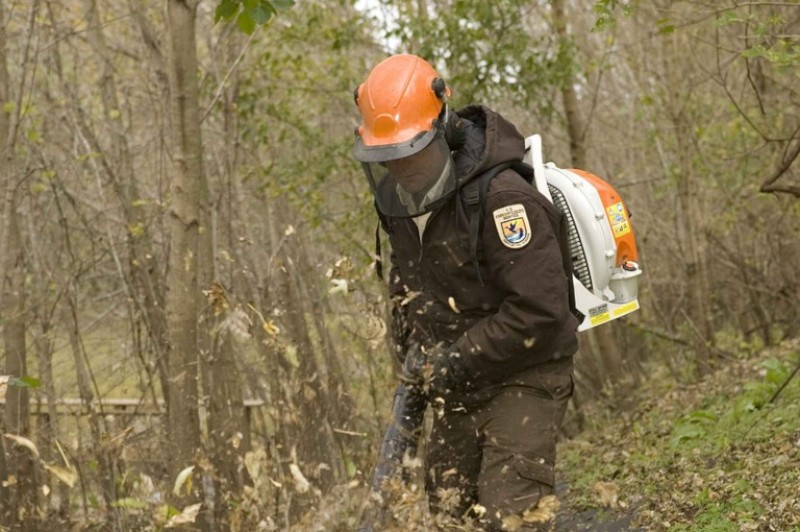Every Thursday our next-door neighbor hires a worker to use a leaf blower. This infernal machine drives me nuts. Rather than letting a pet peeve render me literally insane, I’ve decided to explore the leaf blower’s deeper significance. A psychologist might call this writing therapy. Maybe the result can also provide a little relief for you, the reader, if you share my irritation.
The most obvious critique of the leaf blower is that it’s an obnoxious, destructive piece of machinery. As everyone within earshot of one knows, gasoline-powered leaf blowers are noisy. Deafening, in fact. The device blasts 95 to 115 decibels of sound at its operator. According to the website Dangerous Decibels, this is roughly equivalent to a chainsaw or a passenger jet taking off, and it can cause permanent hearing loss. Further, research into the specific characteristics of sound from gas-powered leaf blowers, published in the Journal of Environmental and Toxicological Studies, showed that, unlike most other loud machines, leaf blowers produce low-frequency noise that travels long distances and penetrates building walls. That’s why a single leaf blower can annoy an entire neighborhood.
Leaf blowers contribute significantly to worsening noise pollution in cities. Wildlife experience chronic stress as a result, with birds having to sing louder to find mates or define breeding territory. Everyone—human or non-human—feels on edge when that ugly noise starts up.
At the same time, leaf blowers emit toxic pollution. The blower’s two-stroke engine drinks a combustible mix of oil and gas, but a typical leaf blower burns just two-thirds of its fuel, spewing the rest into the air. That’s why two-stroke gas engines have been phased out in nearly all applications—except landscape maintenance. The noxious stew of gases released by leaf blowers—including cancer-causing benzene, volatile organic compounds, ozone, and nitrogen oxides—is a health hazards for workers and bystanders alike.
Regarding nitrogen oxide, the California Air Resources Board figures that using a gas-powered leaf blower for an hour emits as much as driving a Toyota Camry from Los Angeles to Denver. Of course, gas-powered leaf blowers also spew climate-wrecking CO2, but their nitrogen oxide emissions have an outsized climate impact: the EPA estimates that one pound of nitrous oxide has almost 300 times as much global warming effect as a pound of carbon dioxide.
All of these drawbacks have led over 100 cities and towns across the country to ban or restrict the use of gas-powered leaf blowers. California is phasing out gas-powered leaf blowers, but doing so will take many years. My neighbor obviously hasn’t gotten the memo, nor have millions like him.
It Goes Deeper
People use leaf blowers, blasting air at up to 280 miles an hour, to remove tree leaves, with the ultimate goal of keeping their lawns looking neat. But leaf litter is habitat for worms and insect larvae. Leaf blowers are just one reason the total biomass of insects on the planet is declining by about 2 percent per year. Leaf litter also protects and builds topsoil, of which we’re losing tens of billions of tons per year globally. So, we’re using noisy, polluting machines to do things that, in many cases, we really shouldn’t be doing in the first place.
The leaf blower replaces muscle-powered work, thereby increasing what economists call labor productivity. In this respect it’s just like a wide range of other industrial machines. From the powered loom, which displaced workers in early industrial Britain, to artificial intelligence (AI), which now threatens the livelihoods of millions of information workers worldwide, new machines disrupt economic routines. They make life easier in certain respects, but in doing so they impose environmental and social costs that often eventually overshadow the immediate benefits.
Physical work can be hazardous, particularly if it involves powered machinery or chemicals. But it provides needed exercise, along with the psychological benefit of seeing a process through from start to finish. Do we really want a future in which all we do is push buttons and stare at screens (the button-pushing eventually to be replaced with a brain-computer interface)? Techno-optimists may say that, with ever more machines in our lives, we will be freed to get our exercise by doing yoga or playing pickleball rather than from back-breaking toil. But survival that’s no longer tied to physical effort can leave us feeling unmotivated and useless. Perhaps our rush to increase labor productivity by replacing muscle power with machine power has passed the point of diminishing returns.
Then there’s the problem of economic inequality. Who actually uses leaf-blowers? In most cases, it’s low-income landscape workers, who are exposed to the air pollution and noise from leaf blowers at close range over sustained periods of time. Gas-powered lawn care has been linked to debilitating health issues like cancer, asthma, heart disease, and hearing loss; so, unsurprisingly, it’s the less-well-off who face the brunt of those health insults.
Stepping back, we see this general pattern reflected in the rest of industrial society: just as leaf-blower noise and air pollution gets shunted mostly toward low-paid landscape workers, resource extraction and polluting industries tend to be located near marginalized communities, nationally and globally. Therefore, the leaf blower just binds us more strongly to already unfair and dangerous social trends.
Continues...
https://www.resilience.org/stories/2023-11-01/the-gasoline-powered-leaf-blower-as-a-metaphor-for-industrial-society/




